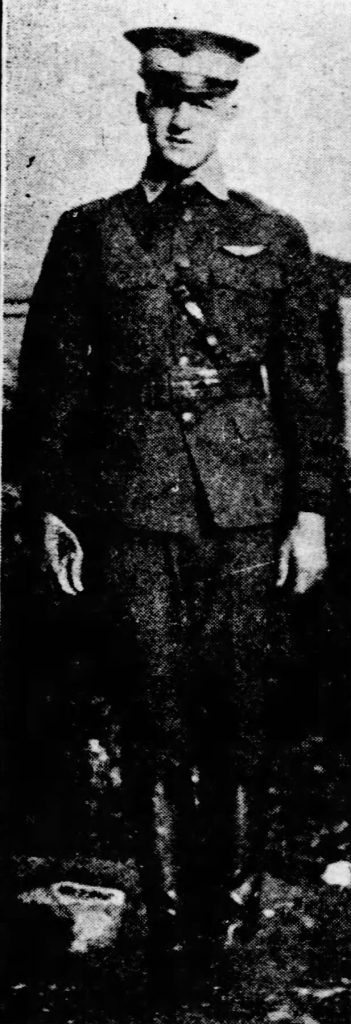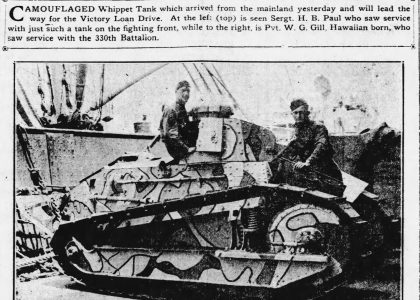A Honolulu Aviator’s Service and Sacrifice
 John Stanley O’Dowda was born on November 28, 1896, in ʻEwa, Oʻahu, the son of Thomas P. and Lillu O’Dowda. His early life was shaped by the rhythms of plantation Hawaiʻi—his father worked as chief boiler operator at the ʻEwa Mill, a role emblematic of the labor-driven economy of the islands. The family later moved to Honolulu, settling on Anapuni Street (Honolulu Star-Advertiser, 1918, December 6, p. 7).
John Stanley O’Dowda was born on November 28, 1896, in ʻEwa, Oʻahu, the son of Thomas P. and Lillu O’Dowda. His early life was shaped by the rhythms of plantation Hawaiʻi—his father worked as chief boiler operator at the ʻEwa Mill, a role emblematic of the labor-driven economy of the islands. The family later moved to Honolulu, settling on Anapuni Street (Honolulu Star-Advertiser, 1918, December 6, p. 7).
A child of the Territory of Hawaiʻi, John was raised during a time of political transformation. Hawaiʻi had been annexed by the United States in 1898 and became a U.S. territory in 1900. Though governed by American law, people from Hawaii were not always treated as full citizens in practice. O’Dowda, however, took advantage of the opportunities he had. He boarded at St. Louis College (1910 Census), later graduating from Punahou (then known as Oʻahu College) in 1914. Athletic, bright, and well-liked, he was lauded as one of the best tennis players in the islands and even served briefly as a sportswriter for The Pacific Commercial Advertiser (Honolulu Star-Advertiser, 1917, September 7, p. 6).
After high school, O’Dowda enrolled at the University of Nevada in Reno. There, he met Ruth Wheeler, a gifted soprano from a well-known Reno family. Their relationship blossomed during his college years and would culminate in a wartime marriage (Reno Gazette-Journal, 1918, July 18, p. 4).
When the United States entered World War I in April 1917, John volunteered for military service. He enlisted in the Aviation Section of the Signal Corps via the University of California at Berkeley and was ordered to report to the School of Military Aeronautics for training (Honolulu Star-Advertiser, 1917, September 7, p. 6).
 Yet, despite his American upbringing and clear devotion to country, John’s path into the Army was not without bureaucratic friction. A letter from his father, Thomas P. O’Dowda, to the Honolulu Star-Bulletin in 1918 revealed that his son’s commission had been delayed by a Washington official who questioned whether John, born in Hawaiʻi in 1896, was a U.S. citizen. “Can you beat it?” the elder O’Dowda wrote, astonished that such doubt could exist. He had to urgently cable for documentation proving citizenship, even though the Organic Act of 1900 had granted citizenship to individuals born in Hawaiʻi after annexation. The issue was eventually resolved, but the moment reflected a larger truth: that many people from Hawaii who were eager to serve had to first prove they belonged (Honolulu Star-Bulletin, 1918, April 10, p. 1).
Yet, despite his American upbringing and clear devotion to country, John’s path into the Army was not without bureaucratic friction. A letter from his father, Thomas P. O’Dowda, to the Honolulu Star-Bulletin in 1918 revealed that his son’s commission had been delayed by a Washington official who questioned whether John, born in Hawaiʻi in 1896, was a U.S. citizen. “Can you beat it?” the elder O’Dowda wrote, astonished that such doubt could exist. He had to urgently cable for documentation proving citizenship, even though the Organic Act of 1900 had granted citizenship to individuals born in Hawaiʻi after annexation. The issue was eventually resolved, but the moment reflected a larger truth: that many people from Hawaii who were eager to serve had to first prove they belonged (Honolulu Star-Bulletin, 1918, April 10, p. 1).
After completing his flight training at Gerstner Field in Louisiana, O’Dowda was commissioned and assigned to a bombing squadron. In July 1918, just before his deployment, he married Ruth Wheeler in Dallas, Texas—a brief window of happiness before war’s demands called him overseas (Reno Gazette-Journal, 1918, July 18, p. 4).
By the fall of 1918, Lieutenant O’Dowda was flying missions in France. Tragically, he died on November 13, 1918—just two days after the Armistice—when his plane crashed near Taugnat, France, during a 135-mile reconnaissance mission. Both he and his observer were killed in the accident (Honolulu Star-Bulletin, 1919, January 4, p. 5).
The loss deeply moved those who knew him and even those who did not. A French woman who witnessed the crash wrote to his parents, describing how she and others kept vigil over the bodies and prayed for the young men’s souls. She expressed gratitude on behalf of her country, saying the victory belonged as much to these fallen “children” as to the living (Honolulu Star-Bulletin, 1919, January 4, p. 5).
Lieutenant O’Dowda was buried with military honors in an American cemetery near Clermont-Ferrand. A letter from a Y.M.C.A. secretary assured his family that “we could not possibly have had a better burial for our soldier dead” and noted that the French villagers adorned the graves with flowers in remembrance and thanks (Honolulu Star-Bulletin, 1919, January 4, p. 5).
Though Hawaiʻi was not yet a state, men like John S. O’Dowda made clear the islands’ commitment to the American cause. He was one of 29 servicemen from Hawaiʻi who gave their lives in World War I, and his name is inscribed on the Roll of Honor at the War Memorial Natatorium in Waikīkī (War Memorial Natatorium, n.d.). His life and the complications surrounding his citizenship speak volumes about Hawaiʻi’s status during the war: peripheral in geography, but central in spirit.
Sources
Honolulu Star-Advertiser. (1917, September 7). John S. O’Dowda is called to colors, p. 6.
Honolulu Star-Advertiser. (1918, March 25). John O’Dowda of Oahu College, American Aviator, p. 2.
Honolulu Star-Advertiser. (1918, December 6). Lieut. O’Dowda killed in France, p. 7.
Honolulu Star-Bulletin. (1919, January 4). He died for his country; French women watch grave, p. 5.
Honolulu Star-Bulletin. (1918, April 10). Jack O’Dowda’s citizenship, not his dad’s, query, p. 1.
Honolulu Star-Bulletin. (1919, May 10). They gave their all to serve the Stars and Stripes, p. 3.
Reno Gazette-Journal. (1918, July 18). Society, p. 4.
San Francisco Bulletin. (1918, December 17). Newsy events of Nevada, p. 12.
War Memorial Natatorium. (n.d.). Roll of Honor. Retrieved from the plaque at the Waikiki War Memorial Natatorium, Honolulu, Hawaiʻi.


